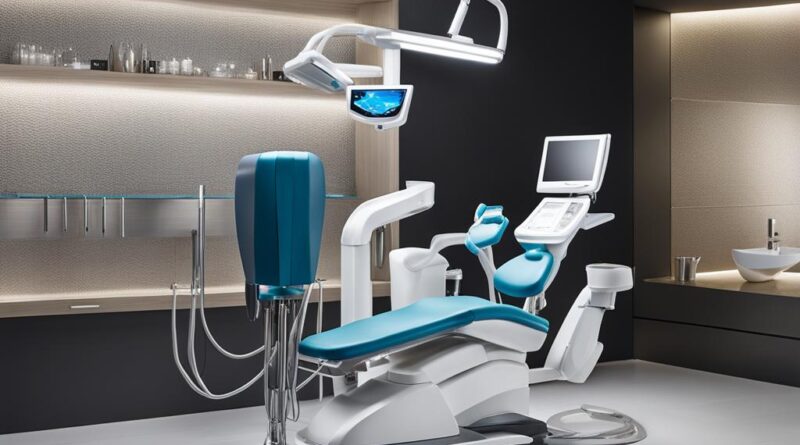Advancing Dental Care: Innovative Solutions
Advancements in dental care and technology are revolutionizing the field of dentistry, enhancing oral health outcomes, and improving patient experiences. Innovative solutions are pushing the boundaries of what was once considered possible, making dental visits more comfortable, efficient, and effective. From digital dentistry to laser technology, these advancements are shaping the future of dental healthcare.
The rapid pace of dental healthcare advancements is driven by a commitment to providing the best possible care and embracing the latest technological breakthroughs. Dentists and dental professionals are constantly seeking innovative solutions that can improve diagnosis, treatment planning, and procedures. These advancements not only benefit patients but also create a more efficient workflow for dental practitioners.
Key Takeaways:
- Advancements in dental care and technology are improving patient experiences and enhancing oral health outcomes.
- Innovative solutions such as digital dentistry and laser technology are shaping the future of dental healthcare.
- Dental professionals are committed to embracing the latest technological breakthroughs to provide the best possible care.
- The rapid pace of dental healthcare advancements benefits both patients and dental practitioners.
- Continued advancements in dental care hold great promise for the future of oral health.
Digital Dentistry: Revolutionizing the Way Dentists Work
Digital dentistry has transformed the dental industry, allowing dentists to work more efficiently and effectively. With the advent of advanced dental technology, traditional methods are being replaced by innovative digital solutions. These digital tools have revolutionized dental procedures, improving patient outcomes and enhancing the overall dental experience.
One of the key advancements in digital dentistry is the use of CAD/CAM (Computer-Aided Design/Computer-Aided Manufacturing) technology. This cutting-edge technology enables dentists to create precise digital impressions and design custom restorations, such as crowns and bridges, with utmost accuracy and efficiency. Through CAD/CAM technology, dentists can streamline the fabrication process, reducing patients’ chair time and providing them with high-quality, custom-made dental restorations in a matter of hours.
Another invaluable tool in digital dentistry is computer-guided implant surgery. Utilizing 3D imaging and virtual planning software, dentists can accurately place dental implants with maximum precision. Computer-guided implant surgery not only ensures optimal implant placement but also enhances the predictability and success rate of implant procedures. Patients benefit from shorter treatment times, improved aesthetics, and reduced post-operative discomfort.
In addition, digital impressions have replaced traditional putty impressions, offering patients a more comfortable and accurate experience. With digital impressions, dentists use intraoral scanners to capture detailed 3D images of patients’ teeth and gums. This eliminates the need for messy impression materials and allows for more efficient communication between dental professionals and dental laboratories.
With the rise of digital dentistry, dentists can also leverage the power of data and analytics to enhance the diagnostic and treatment planning process. Digital records and imaging enable dentists to analyze intricate details and make informed decisions for personalized treatment plans. This data-driven approach not only improves diagnostic accuracy but also helps dentists optimize treatment outcomes for each individual patient.
“Digital dentistry has revolutionized the way dentists work, allowing them to provide more precise, efficient, and patient-centered care.”
The Benefits of Digital Dentistry
Digital dentistry offers numerous benefits to both dentists and patients. It enhances diagnostic accuracy, improves treatment planning, and enables dentists to deliver more predictable and successful outcomes. Some of the key advantages of digital dentistry include:
- Improved patient experience with more comfortable procedures
- Reduced treatment time and chairside visits
- Higher quality and more precise restorations
- Enhanced communication between dental professionals
- Increased predictability and success rate of dental procedures
The Future of Digital Dentistry
The field of digital dentistry is constantly evolving, with continuous advancements in technology and innovation. As dental professionals embrace digital solutions, we can expect further improvements in efficiency, precision, and patient care. The integration of artificial intelligence (AI) and machine learning algorithms holds immense potential for enhancing diagnoses, treatment planning, and personalized patient care.
With the ongoing advancements in digital dentistry, the future of dental care looks promising. Dentists are equipped with powerful tools that enable them to provide comprehensive, patient-centered care while delivering exceptional treatment outcomes.
3D Printing: Customized Dental Appliances with Precision
The advent of 3D printing has revolutionized dentistry by enabling the creation of custom dental appliances and prosthetics with high precision and in a shorter timeframe. This groundbreaking dental technology has significantly improved the fabrication process and patient experience.
Traditional methods of creating dental appliances, such as dentures and dental crowns, required multiple steps and manual adjustments. With 3D printing, the process is streamlined and more accurate, resulting in custom-fit appliances that offer enhanced comfort and functionality.
“3D printing has revolutionized the way dentists design and create dental appliances. It allows for highly detailed and precise fabrication, ensuring optimal fit and performance for each individual patient.” – Dr. Emily Anderson, Dental Innovations Specialist
The use of 3D printing in dentistry starts with a digital scan of the patient’s mouth. This scan is used to create a computer-aided design (CAD) model of the desired dental appliance. The CAD model is then sent to the 3D printer, which uses layer-by-layer additive manufacturing techniques to build the appliance.
One of the key advantages of 3D printing is its ability to produce highly accurate and detailed dental appliances. The level of precision achieved with this technology ensures an excellent fit, reducing the need for adjustments and enhancing patient comfort. In addition, 3D printing allows for the creation of complex structures and intricate designs that were previously challenging to achieve using traditional fabrication methods.
The time required to produce custom dental appliances using 3D printing is significantly reduced compared to traditional techniques. With traditional methods, patients often had to wait several weeks to receive their final dental appliances. With 3D printing, the turnaround time can be as little as a few days, allowing patients to get their restorations faster and reducing the number of dental appointments required.
Benefits of 3D Printing in Dentistry
- Customization: 3D printing enables the creation of personalized dental appliances that perfectly fit each patient’s unique oral structure.
- High Precision: The additive manufacturing process of 3D printing ensures exceptional accuracy and detail in the fabrication of dental appliances, leading to improved functionality and aesthetics.
- Efficient Production: 3D printing reduces the time and resources required to produce dental appliances, resulting in quicker turnaround times for patients.
- Enhanced Patient Experience: Custom-fit dental appliances created with 3D printing offer superior comfort and function, improving patient satisfaction.
In conclusion, 3D printing has revolutionized dentistry by introducing a new level of precision and efficiency in the fabrication of custom dental appliances. This advanced dental technology has improved the patient experience by providing highly accurate, personalized, and comfortable dental restorations.

Laser Dentistry: Less Invasive and More Precise Procedures
Laser dentistry has transformed the field of dental healthcare by revolutionizing treatment options to be less invasive and more precise. This innovative dental technology has paved the way for procedures like gum reshaping and cavity removal that are performed with minimal discomfort and faster healing times.
The use of lasers in dentistry offers numerous advantages. Firstly, it eliminates the need for traditional surgical instruments, such as scalpels and drills, reducing the invasiveness of procedures. This results in less bleeding, reduced trauma to the surrounding tissues, and ultimately leads to a more comfortable dental experience for patients.
Additionally, laser dentistry allows for improved precision in dental procedures. Dentists can precisely target and remove diseased gum tissue, decontaminate the root canals, or perform cavity removal with unparalleled accuracy. The laser energy helps in disinfecting the treated area, reducing the likelihood of future infections.
Furthermore, laser dentistry promotes faster healing times compared to traditional methods. The laser’s ability to stimulate cellular regeneration and tissue growth minimizes post-treatment discomfort and reduces the overall recovery period. With less downtime, patients can resume their daily activities sooner.
Consider the following benefits of laser dentistry:
- Minimally invasive procedures
- Enhanced precision and accuracy
- Faster healing times
- Reduced post-treatment discomfort
- Improved patient experience
Using laser dentistry, dentists can achieve exceptional results while minimizing patient discomfort. It’s a remarkable advancement in dental technology that has transformed the way we approach various dental procedures.
Gum Reshaping with Laser Dentistry
One of the remarkable applications of laser dentistry is gum reshaping, also known as gum contouring or gum surgery. This procedure involves sculpting the gum line to enhance the appearance and health of patients’ smiles. Laser technology allows for precise and controlled removal of excessive gum tissue, improving the symmetry and balance of the smile.
The advantages of using lasers in gum reshaping include:
- Minimal bleeding
- Reduced discomfort
- Precise gum reshaping
- Improved post-treatment healing
With laser gum reshaping, patients can achieve a more aesthetically pleasing smile while experiencing a quicker and more comfortable recovery.
Cavity Removal with Laser Dentistry
Laser dentistry has also revolutionized the way cavities are treated. With the use of lasers, dentists can precisely remove decayed tooth structure while preserving healthy tooth enamel. This targeted approach allows for more conservative cavity treatment.
The benefits of laser cavity removal include:
- Precise removal of decay
- Preservation of healthy tooth structure
- Reduced need for local anesthesia
- Enhanced patient comfort
Moreover, laser cavity removal eliminates the noise and vibration associated with traditional dental drills, making it a more pleasant experience for patients who may feel anxious during dental procedures.
| Laser Dentistry Benefits | Traditional Dentistry |
|---|---|
| Minimally invasive procedures | Invasive procedures with scalpels and drills |
| Enhanced precision and accuracy | Potential human error |
| Faster healing times | Longer recovery periods |
| Reduced post-treatment discomfort | Higher post-treatment discomfort |
| Improved patient experience | Less comfortable dental experience |
Teledentistry: Remote Diagnoses and Treatments
Teledentistry is revolutionizing the way dentists provide diagnoses and treatments by leveraging telecommunication technology. Through remote dental consultations, patients can receive dental care regardless of their location, improving access to dental services, particularly in remote or underserved areas. With the help of dental technology, dentists can remotely assess patients, diagnose oral health conditions, and provide personalized treatment plans.
One of the key advantages of teledentistry is its ability to connect patients with dental professionals without the need for in-person visits. Remote consultations allow patients to receive expert advice and guidance from the comfort of their homes, saving time and reducing travel costs. This is especially beneficial for individuals with limited mobility, those living in rural areas, or patients who may have difficulty visiting a dental clinic due to various reasons.
Teledentistry also plays a vital role in preventive dental care. Dentists can remotely educate patients about oral hygiene practices, dietary habits, and regular dental check-ups. They can also provide guidance on how to properly care for dental appliances such as braces or dentures. By promoting preventive measures, teledentistry helps in maintaining optimal oral health and preventing dental issues from progressing further.
Moreover, remote dental consultations are facilitated through secure digital platforms that ensure patient privacy and confidentiality. Dentists can securely access patients’ dental records, X-rays, and images, allowing for accurate diagnoses and comprehensive treatment planning. Patients can also securely share their oral health concerns, symptoms, and medical history with dentists, ensuring a thorough and personalized approach to their dental care.
Despite its many advantages, it’s important to note that teledentistry has limitations. It cannot replace all in-person dental procedures or emergency treatments that require immediate physical intervention. However, it serves as a valuable tool for initial assessments, follow-up consultations, minor dental issues, and regular check-ups.
By embracing teledentistry and leveraging dental technology, dentists can bridge the gap in dental care access, improve patient outcomes, and enhance the overall dental experience.
“Teledentistry is transforming the way dentists reach and treat patients, breaking barriers and improving access to dental care. Through remote consultations, patients can receive expert guidance without the need for in-person visits, making dental care more convenient and accessible than ever before.”
Benefits of Teledentistry:
- Improved access to dental care, particularly in remote or underserved areas
- Convenient and time-saving remote consultations
- Promotion of preventive dental care and education
- Secure digital platforms ensuring patient privacy and confidentiality
Limitations of Teledentistry:
- Cannot replace all in-person dental procedures
- Emergency treatments requiring immediate physical intervention

| Teledentistry | Traditional Dentistry | |
|---|---|---|
| Access to Dental Care | Provides access to dental care from remote locations | Requires physical presence at a dental clinic |
| Cost and Convenience | Reduces travel expenses and saves time | May involve travel and waiting time |
| Preventive Care | Enables remote education and guidance on oral health | In-person dental appointments for preventive care |
| Emergency Treatments | Lacks immediate physical intervention for emergencies | Immediate treatment for dental emergencies |
Dental Implant Innovations: Improving Materials and Techniques
Dental implant advancements have revolutionized the field of dentistry, providing patients with improved outcomes and a more enhanced experience. These advancements are the result of continuous research and development in dental technology, leading to improvements in materials and techniques used in dental implant procedures.
One of the key areas of advancement in dental implants is the development of improved materials. Traditional dental implants are typically made of titanium, a strong and biocompatible material. However, recent advancements have led to the introduction of innovative materials that offer even greater benefits.
Table: Dental Implant Materials Comparison
| Material | Advantages | Disadvantages |
|---|---|---|
| Titanium | Strong and biocompatible | – |
| Zirconia | Natural-looking and highly aesthetic | Less flexibility than titanium |
| Hybrid | Combination of titanium and ceramic for improved strength and aesthetics | – |
The use of zirconia implants has gained popularity due to its natural appearance and high biocompatibility. Zirconia implants offer excellent aesthetics and are especially preferred for front tooth replacements. Hybrid implants, which combine the strength of titanium with the aesthetic qualities of ceramic, provide a great balance between function and appearance.
Advanced Techniques in Dental Implant Placement
In addition to improved materials, advanced techniques have also contributed to the success of dental implant procedures. Computer-guided implant surgery is one such technique that enhances the precision and accuracy of implant placement.
“Computer-guided implant surgery allows for a more predictable outcome and reduces the risk of complications. It involves the use of digital imaging and software to create a 3D model of the patient’s mouth, allowing the dentist to plan the implant placement with utmost accuracy.”
This technology enables dentists to visualize the patient’s anatomy in detail and determine the optimal position for the implants. As a result, it ensures proper alignment, stability, and long-term success of the implants.
Dental implant advancements have indeed revolutionized the field of dentistry, offering patients improved materials and advanced techniques that enhance the success and longevity of dental implants. These innovations continue to shape the future of dental care, providing patients with better outcomes and a more satisfying dental experience.
AI in Dentistry: Enhancing Diagnoses and Treatment Plans
Artificial intelligence (AI) is rapidly transforming the field of dentistry, revolutionizing the way dentists diagnose oral health conditions and develop personalized treatment plans. By leveraging AI technology, dentists can improve the accuracy, efficiency, and outcomes of dental procedures, ultimately providing patients with enhanced dental care.
One of the key benefits of AI in dentistry is its ability to process and analyze vast amounts of data quickly and accurately. Through machine learning algorithms, AI systems can identify patterns and trends in dental images, patient records, and treatment outcomes, helping dentists make more informed decisions about diagnoses and treatment plans.
AI-powered dental technology also enables dentists to develop personalized treatment plans tailored to each patient’s specific needs. By considering factors such as medical history, genetic information, and lifestyle habits, AI algorithms can generate optimized treatment recommendations that take into account a patient’s unique circumstances.
Improved Treatment Plans
With AI technology, dentists can provide patients with treatment plans that are not only more accurate but also result in improved outcomes. AI algorithms can analyze a vast range of data to predict the success rates of different treatment options, helping dentists choose the most effective approach for each patient.
AI technology has the potential to revolutionize the field of dentistry, enhancing diagnoses and treatment plans. By harnessing the power of artificial intelligence, dentists can provide more precise and personalized care, leading to improved patient experiences and outcomes.
In addition, AI systems can assess risk factors and predict potential complications, enabling dentists to take proactive measures to prevent adverse events during treatment. By providing dentists with valuable insights and recommendations, AI technology ensures that treatment plans are tailored to each patient’s specific needs, optimizing the chances of successful outcomes.
Enhanced Diagnoses
AI technology is also revolutionizing the way oral health conditions are diagnosed. Through image recognition algorithms, AI systems can analyze dental images, such as X-rays and intraoral scans, with a level of accuracy and efficiency that surpasses human capabilities. This allows dentists to detect dental issues, such as cavities, gum diseases, and abnormalities, at earlier stages, leading to more effective and timely interventions.
By assisting dentists in accurately identifying potential issues, AI technology enables early intervention, preventing the progression of oral health conditions and minimizing the need for extensive and expensive treatments. This not only saves patients from unnecessary discomfort but also reduces healthcare costs in the long run.
Future Possibilities
The integration of AI in dentistry is still in its early stages, but the potential for further advancements is promising. As AI technology continues to evolve, we can expect even more sophisticated diagnostic tools, personalized treatment recommendations, and improved patient outcomes.
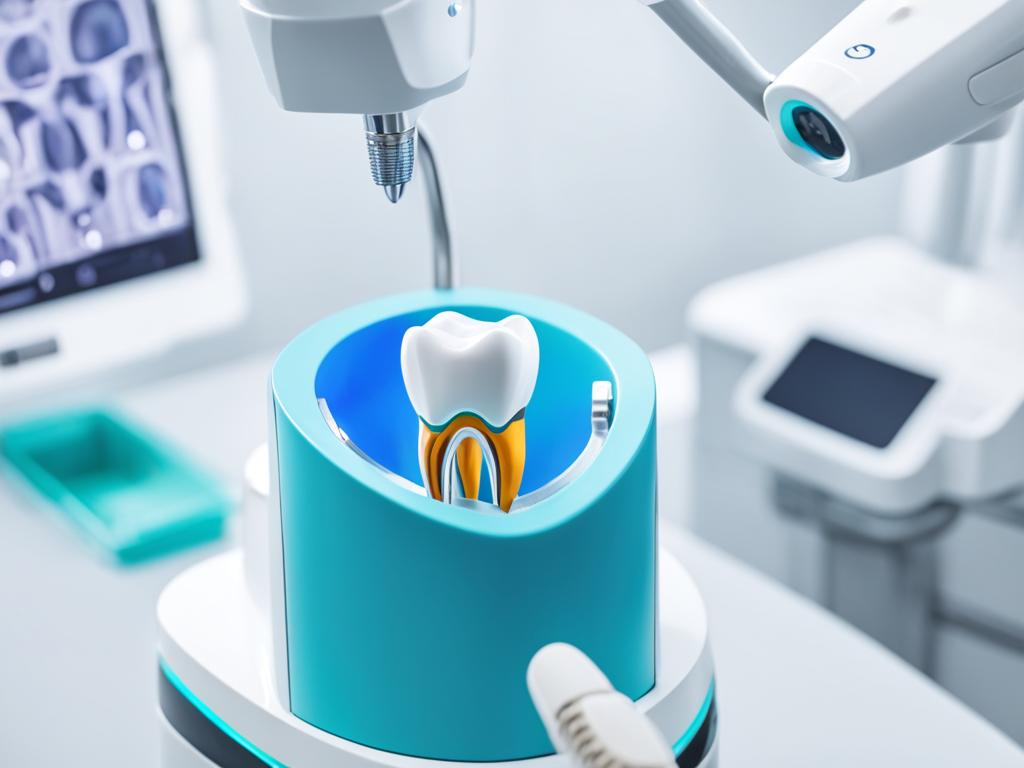
| Benefits of AI in Dentistry | Improved Diagnosis | Enhanced Treatment Plans |
|---|---|---|
| Efficient and accurate analysis of vast amounts of data | Early detection of oral health conditions | Personalized treatment recommendations |
| Prediction of treatment success rates | Reduced risk and prevention of complications | Optimization of patient outcomes |
| Cost savings through early intervention | More effective and timely interventions | Continued advancements and possibilities for the future |
Intraoral Cameras: Improving Diagnosis and Treatment Precision
Intraoral cameras have revolutionized dental technology by providing dentists with detailed and accurate imaging of the mouth. These small, handheld devices allow for better diagnoses and more precise treatment, significantly enhancing the overall dental experience for both the dentist and the patient.
With intraoral cameras, dentists can capture high-resolution images and videos of the inside of the mouth. This detailed imaging aids in the detection and diagnosis of various dental conditions, such as cavities, gum disease, and oral abnormalities. By capturing images in real-time, dentists can assess the condition of the teeth and gums with greater accuracy, leading to more effective treatment plans.
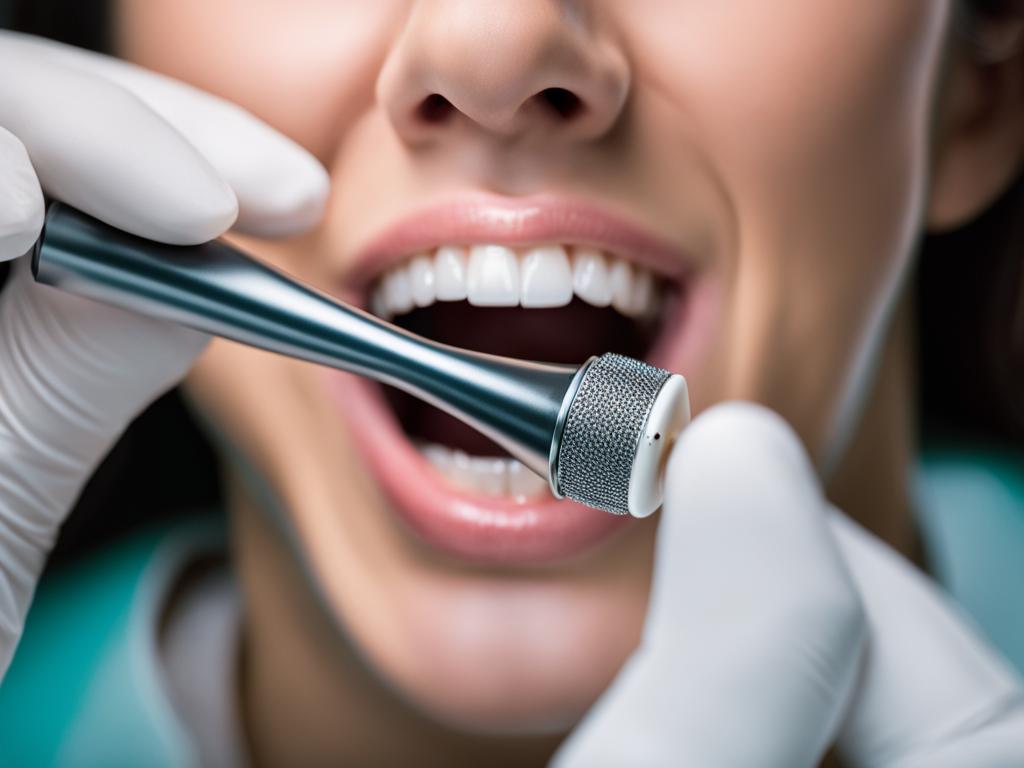
The use of intraoral cameras also allows dentists to educate their patients about their oral health. By visually showing patients the areas of concern, dentists can explain the treatment options more effectively, ensuring better patient understanding and collaboration in the decision-making process.
In addition to improving diagnosis, intraoral cameras aid in the precise execution of dental procedures. Dentists can visualize hard-to-reach areas and perform more accurate dental work, such as placing fillings, crown preparations, and orthodontic treatments. This technology enables dentists to achieve better treatment outcomes and improve the longevity of dental restorations.
“Intraoral cameras have been a game-changer in dentistry. The ability to capture detailed images of the mouth has revolutionized the way we diagnose and treat our patients. It allows us to provide more precise and personalized care, leading to better patient outcomes.”
– Dr. Emily Rodriguez, DDS
Advantages of Intraoral Cameras:
- Clear and detailed imaging of the mouth
- Early detection of dental problems
- Improved patient communication and education
- Precise execution of dental procedures
- Enhanced treatment outcomes
In conclusion, intraoral cameras have transformed the field of dentistry by providing detailed imaging and enhancing the precision of dental diagnoses and treatments. This advanced technology improves patient experiences, enables better communication, and contributes to more effective dental procedures. With intraoral cameras, dentists can deliver high-quality dental care and help patients achieve optimal oral health.
CAD/CAM: Custom Dental Restorations in Hours
In today’s rapidly evolving dental landscape, CAD/CAM technology stands at the forefront of dental innovation. CAD/CAM, which stands for Computer-Aided Design/Computer-Aided Manufacturing, has revolutionized the fabrication process for custom dental restorations, making it faster, more efficient, and highly precise. With CAD/CAM, patients can now have their dental restorations created in a matter of hours, rather than enduring multiple visits over several weeks.
The CAD/CAM process begins with the dentist taking a digital impression of the patient’s teeth using an intraoral scanner. This scanner captures a detailed 3D image of the patient’s mouth, eliminating the need for messy traditional impressions. The digital impression is then fed into CAD software, which allows the dentist to design a customized dental restoration with precise specifications.
Once the design is complete, the CAD file is sent to a CAM machine, where the restoration is fabricated using advanced milling or 3D printing technology. The CAD/CAM system ensures exceptional accuracy, as the software guides the machine to carve out the dental restoration with meticulous precision. The result is a restoration that fits seamlessly with the patient’s natural teeth, providing optimal function and aesthetics.
CAD/CAM technology offers numerous benefits for both patients and dentists. Patients enjoy the convenience of same-day restorations, eliminating the need for multiple appointments and temporary restorations. The efficient fabrication process saves valuable time, allowing patients to receive their final dental restorations quickly and efficiently.
Dentists also benefit from CAD/CAM technology, as it enhances their ability to provide high-quality restorations. The digital workflow eliminates the potential for human error that can occur in traditional, manual fabrication processes. Dentists can also make real-time adjustments to the design if necessary, ensuring that the restoration meets the patient’s specific needs and preferences.
The Benefits of CAD/CAM Technology in Dentistry:
- Rapid fabrication of custom dental restorations
- Precise and accurate fit
- Elimination of messy traditional impressions
- Saves time with same-day restorations
- Improved patient satisfaction
CAD/CAM technology has truly transformed the field of dentistry by streamlining the fabrication process and delivering custom dental restorations with unparalleled precision and efficiency. Patients can now experience the convenience of having their restorations created in a single visit, while dentists can provide optimal outcomes and enhance patient satisfaction. With CAD/CAM technology, the future of dental restorations is undoubtedly brighter than ever before.
“CAD/CAM technology has revolutionized the way we fabricate custom dental restorations. It’s incredibly efficient and precise, allowing us to provide our patients with high-quality same-day restorations. The convenience and satisfaction it brings to our patients are truly remarkable.”

Digital X-rays: Faster, Safer, and Higher Quality Imaging
Digital X-rays have revolutionized dental imaging by providing faster and safer results with improved image quality. This innovative dental technology has transformed the way dentists diagnose and treat patients, enhancing diagnostic capabilities and improving overall patient care.
Gone are the days of traditional film-based X-rays that required chemical processing and lengthy waiting times for results. With digital X-rays, dentists can capture high-resolution images of the teeth and surrounding oral structures in a matter of seconds. The images can then be instantly viewed on a computer screen, allowing for immediate analysis and treatment planning.
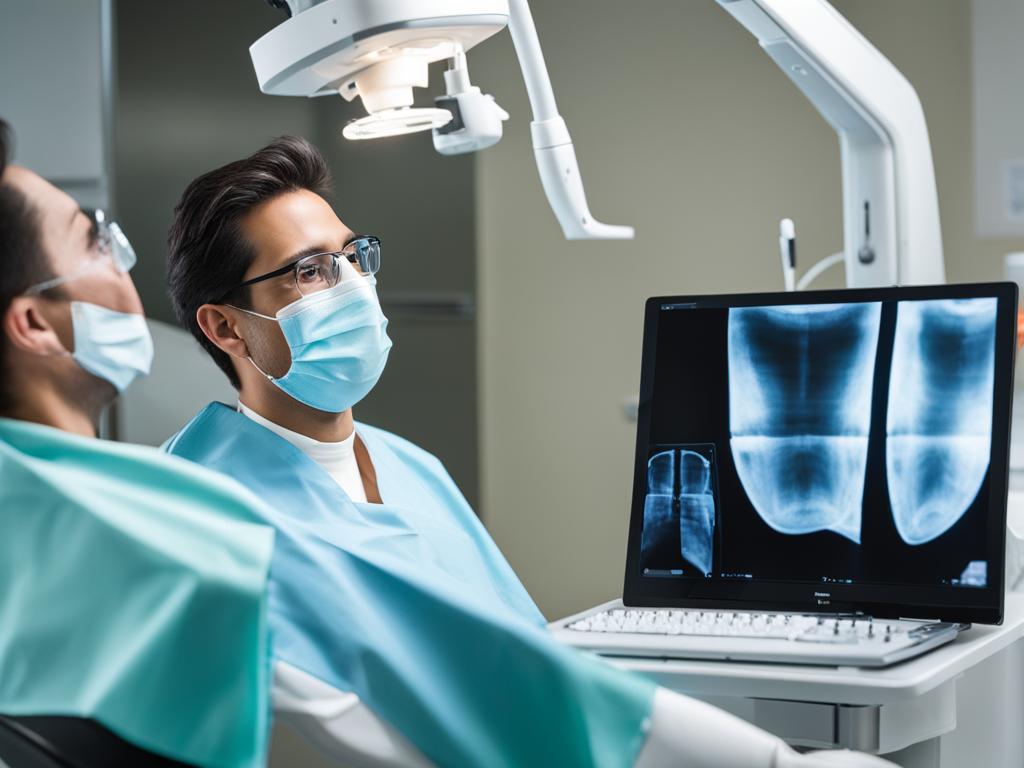
The use of digital X-rays eliminates the need for hazardous chemicals used in film processing, making it a safer and more eco-friendly option. Patients are also exposed to significantly less radiation compared to traditional X-rays, further ensuring their safety and well-being during dental procedures.
Not only are digital X-rays faster and safer, but they also offer improved image quality. The digital technology allows for enhanced image contrast, clarity, and precision, making it easier for dentists to detect and diagnose dental conditions such as cavities, fractures, and affected tooth roots.
“Digital X-rays have transformed the way we provide dental care. The faster imaging process, combined with improved image quality, allows us to deliver more accurate diagnoses and develop precise treatment plans for our patients.”
– Dr. Emily Anderson, DDS
In addition to their diagnostic benefits, digital X-rays also enable dentists to easily share images with other dental specialists, if needed, for collaborative treatment planning. Patients can also have a better understanding of their oral health conditions as dentists can utilize visual aids during discussions and explanations.
Benefits of Digital X-rays:
- Quicker imaging process, reducing patient wait times
- Reduced radiation exposure for patients
- Improved image quality for enhanced diagnostic capabilities
- Environmentally friendly, eliminating the need for chemical processing
- Easy sharing of images for collaborative treatment planning
Overall, digital X-rays have revolutionized the field of dental imaging, providing dentists with faster, safer, and higher quality results. By leveraging this advanced dental technology, dentists can deliver more accurate diagnoses and develop precise treatment plans, ultimately improving patient outcomes and satisfaction.
Dental Microscopes: Enhancing Precision and Visibility
In the field of dentistry, precision and visibility are crucial for successful procedures. Dental microscopes are invaluable tools that provide dentists with enhanced visibility, allowing them to perform precise and accurate procedures. This advanced dental technology is particularly beneficial for complex treatments, such as root canal treatments, where precision is paramount.
The use of dental microscopes revolutionizes the way dentists approach procedures by magnifying the treatment area, allowing for a more detailed examination. With the increased visibility provided by the microscope, dentists can identify intricate anatomical structures, diagnose issues more accurately, and plan treatment strategies with greater precision.
“Dental microscopes have transformed the way we practice dentistry. They provide unparalleled visibility and allow us to perform procedures with a level of precision that was not possible before.”
– Dr. Emily Thompson, DDS
By incorporating dental microscopes into their practice, dentists can better visualize the intricate details of the oral cavity. This level of visibility enables them to detect and treat dental issues at an early stage, minimizing the risk of complications and ensuring optimal patient outcomes.
In addition to enhanced visibility, dental microscopes also offer ergonomic benefits for the dentist. These microscopes are designed to provide optimal working positions, reducing strain and improving overall comfort during procedures. Dentists can maintain a better posture and work in a more relaxed position, leading to improved focus and concentration.
Furthermore, dental microscopes facilitate effective communication between the dentist and the patient. By using the microscope’s visual capabilities, dentists can show patients the intricate details of their oral health, increasing patient understanding and trust. This transparency enhances the patient’s overall dental experience and instills confidence in the dentist’s abilities.
Benefits of Dental Microscopes:
- Enhanced visibility for precise diagnosis and treatment planning
- Improved detection of dental issues at an early stage
- Minimized risk of complications
- Optimal working positions for dentists, reducing strain
- Improved focus and concentration during procedures
- Enhanced communication between dentist and patient
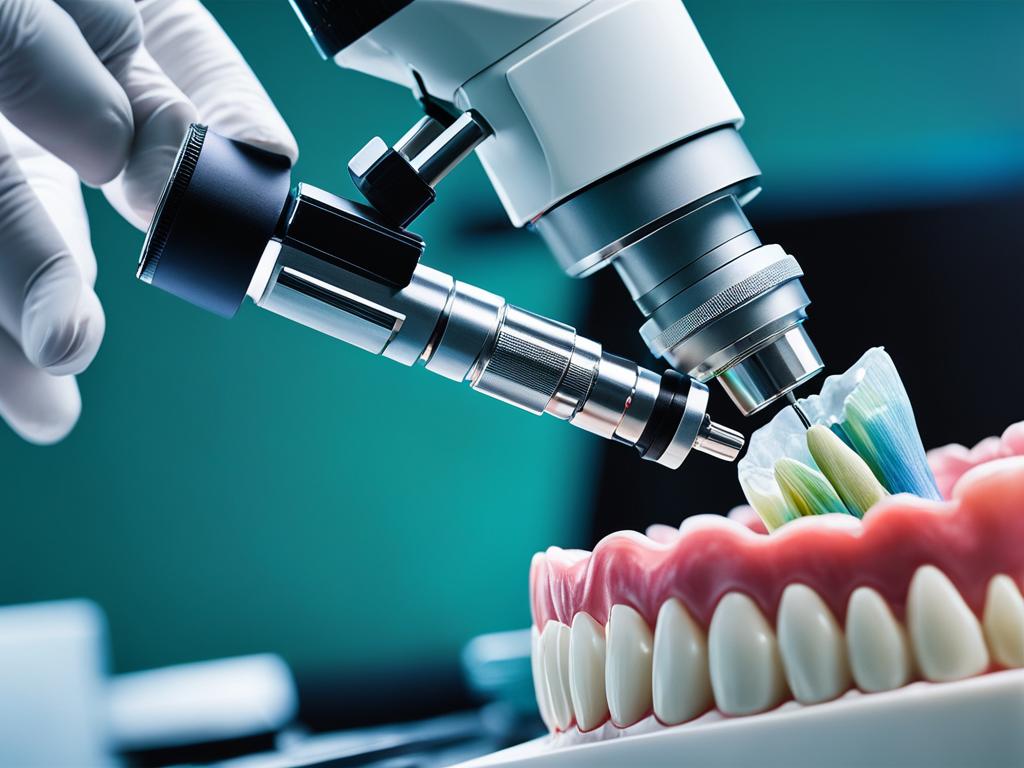
| Procedure | Without Dental Microscope | With Dental Microscope |
|---|---|---|
| Root Canal Treatment | Difficulty in identifying complex canal anatomy | Precise visualization of intricate canal structures for efficient treatment |
| Periodontal Surgery | Limited visualization of gum tissue and tooth root surfaces | Detailed examination of gum tissue and precise surgical planning |
| Restorative Dentistry | Challenges in achieving accurate marginal fit for dental restorations | Highly accurate marginal fit for optimal dental restorations |
As dental technology continues to advance, dental microscopes remain integral to providing unparalleled precision and visibility in dental procedures. By investing in this innovative technology, dentists can offer their patients the highest standard of care and ensure successful treatment outcomes.
Dental Sealants and Tooth-Colored Fillings: Improved Cavity Prevention
In the realm of dental technology, advancements in dental sealants and tooth-colored fillings have significantly improved cavity prevention and restorative treatments.
Traditional dental sealants have been used for decades as a preventive measure against tooth decay. However, modern dental sealants have benefited from technological advancements, allowing for better adhesion and durability. These sealants are made from a tooth-colored resin material, providing a discreet and natural-looking solution for cavity prevention. By sealing the deep grooves and fissures of the teeth, dental sealants create a barrier that protects against bacteria and plaque buildup. With improved materials and application techniques, dental sealants offer enhanced longevity and effectiveness in preventing cavities.
Furthermore, tooth-colored fillings, also known as composite fillings, have revolutionized dental restorations. These fillings are made from a blend of materials, including ceramic and plastic, which can be color-matched to the shade of the natural teeth. This allows for seamless integration with the surrounding tooth structure, resulting in a restoration that is virtually indistinguishable from the natural teeth. Not only do tooth-colored fillings enhance the aesthetic appeal of dental restorations, but they also provide excellent durability and bonding strength, ensuring long-lasting results.
Combining the benefits of dental sealants and tooth-colored fillings, patients can experience improved cavity prevention, better oral health, and an attractive smile. Dental technology continues to evolve, offering innovative solutions to enhance the aesthetic appeal and durability of dental treatments.
If you’re interested in seeing the impact of tooth-colored fillings, take a look at the image below:
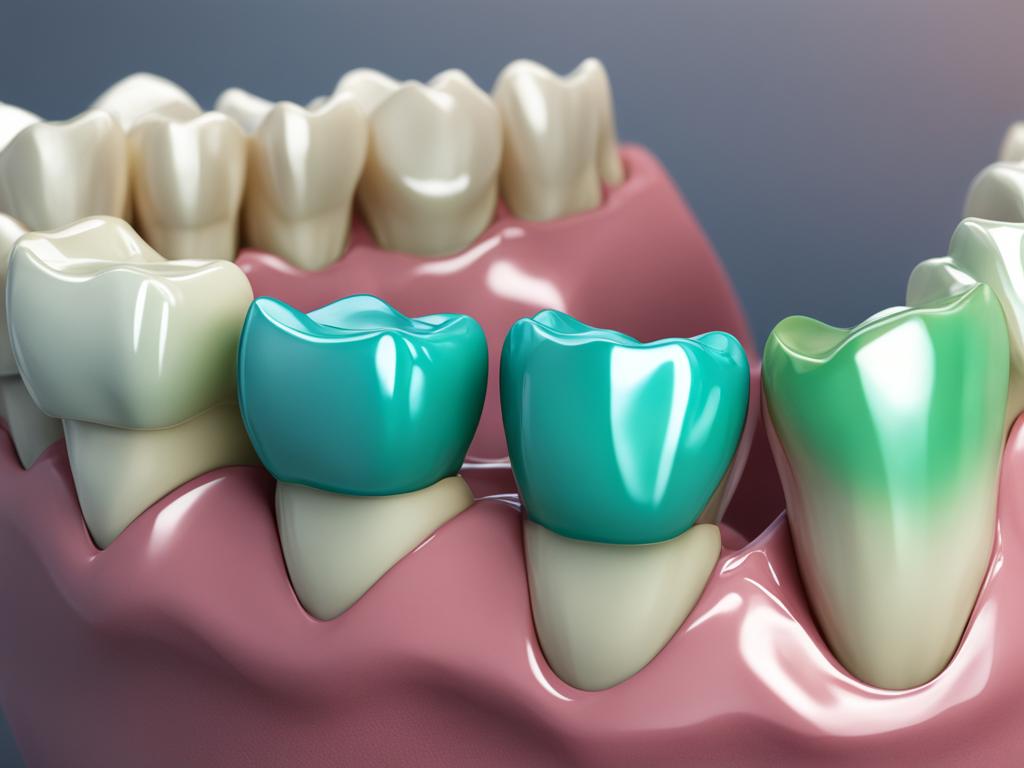
Advantages of Dental Sealants and Tooth-Colored Fillings:
- Improved cavity prevention
- Natural-looking restorations
- Seamless integration with the natural teeth
- Enhanced durability and bonding strength
With the continuous advancement of dental technology, patients can benefit from these innovative solutions that enhance both oral health and aesthetics.
Happynecks: Maximum Comfort and Support for Dental Procedures
Happynecks is an innovative dental cushion designed to provide maximum comfort and support to patients during dental procedures. Made with high-quality foam and ergonomically designed, it reduces strain on the neck and improves the overall patient experience.

During dental procedures, patient comfort is paramount. Happynecks ensures that patients can maintain a relaxed and comfortable position throughout their treatment, minimizing any discomfort or strain on the neck. Its supportive foam material and ergonomic design offer optimal neck support, making the experience more pleasant for patients.
Not only does Happynecks prioritize patient comfort, but it also enhances dentist ergonomics. By providing consistent support for the patient’s neck and head, it helps to reduce the strain on dentists’ backs and shoulders, improving their overall working posture.
“Happynecks has been a game-changer in my practice. Patients often comment on how comfortable they feel during their dental procedures, and it has made a noticeable difference in their overall satisfaction.”
<!–Dr. Emily Johnson, DDS–>
With its innovative design and focus on patient comfort and dentist ergonomics, Happynecks is revolutionizing the dental experience. Patients can now undergo dental procedures with maximum comfort, while dentists can work more effectively and minimize the risk of occupational discomfort.
Conclusion
The dental care industry is undergoing a remarkable transformation with the advent of innovative technologies and advancements. From digital dentistry to laser technology, these dental innovations are revolutionizing the way dentists work and enhancing patient experiences.
With digital dentistry, dentists can now utilize cutting-edge tools like digital impressions, computer-aided design/computer-aided manufacturing (CAD/CAM), and computer-guided implant surgery, resulting in more efficient and effective treatments.
Laser dentistry has contributed to less invasive and more precise procedures, allowing for gum reshaping and cavity removal with minimal discomfort and faster healing times. Furthermore, teledentistry has significantly improved access to dental care by enabling remote consultations and diagnoses, particularly in underserved areas.
These advancements, along with others such as 3D printing, AI integration, and intraoral cameras, have paved the way for a more comfortable and efficient dental experience. As oral health advancements continue to push the boundaries of dental care, patients can look forward to enhanced treatment options and better overall oral health.
FAQ
What is digital dentistry?
Digital dentistry refers to the use of digital technologies in dental practices, allowing dentists to work more efficiently and effectively. It includes tools such as digital impressions, CAD/CAM (computer-aided design/computer-aided manufacturing), and computer-guided implant surgery.
How has 3D printing revolutionized dentistry?
3D printing has revolutionized dentistry by enabling the creation of custom dental appliances and prosthetics with high precision and in a shorter timeframe. This technology has significantly improved the fabrication process and patient experience.
What are the benefits of laser dentistry?
Laser technology has revolutionized dental procedures by offering less invasive and more precise treatment options. It allows for procedures like gum reshaping and cavity removal with minimal discomfort and faster healing times.
What is teledentistry?
Teledentistry is a dental practice that leverages telecommunication technology to remotely assess patients and provide consultations. It has transformed the way dentists diagnose and treat patients, improving access to dental care, especially in remote or underserved areas.
How have dental implant advancements improved patient outcomes?
Dental implant advancements have significantly improved the success and longevity of dental implants. Innovations in materials, techniques, and implant designs have led to better outcomes and an enhanced patient experience.
How is artificial intelligence being integrated into dentistry?
Artificial intelligence is being integrated into dentistry to improve diagnoses, treatment planning, and patient outcomes. AI technology assists dentists in making more accurate and efficient decisions for personalized treatment plans.
What are the benefits of intraoral cameras?
Intraoral cameras provide dentists with detailed and accurate imaging of the mouth, allowing for better diagnoses and more precise treatment. This technology enhances the overall dental experience for both the dentist and the patient.
How does CAD/CAM technology streamline the creation of dental restorations?
CAD/CAM technology in dentistry enables the quick and efficient creation of custom dental restorations. It streamlines the fabrication process, reducing the time patients need to spend in the dentist’s chair.
What are the advantages of digital X-rays?
Digital X-rays have revolutionized dental imaging by providing faster and safer results with improved image quality. This technology enhances diagnostic capabilities and eliminates the need for chemical processing.
How do dental microscopes enhance precision in procedures?
Dental microscopes provide dentists with enhanced visibility, allowing for more precise and accurate procedures. This technology is particularly beneficial for complex treatments, such as root canal treatments.
What are the benefits of dental sealants and tooth-colored fillings?
Dental sealants and tooth-colored fillings have advanced significantly, providing improved cavity prevention and natural-looking restorations. These innovations enhance the aesthetic appeal and durability of dental treatments.
What is Happynecks and how does it improve the patient experience?
Happynecks is an innovative dental cushion designed to provide maximum comfort and support to patients during dental procedures. Made with high-quality foam and ergonomically designed, it reduces strain on the neck and improves the overall patient experience.

